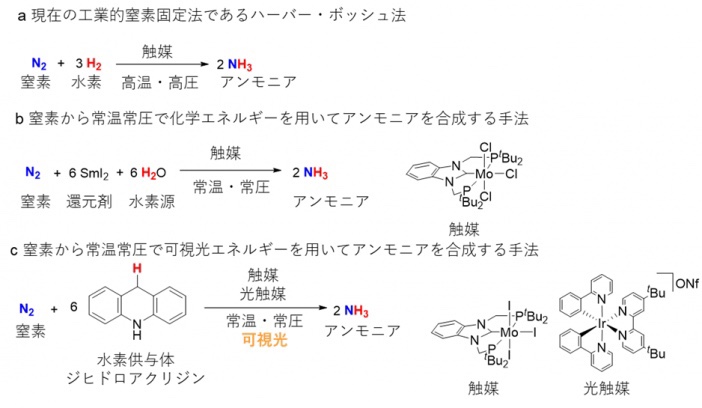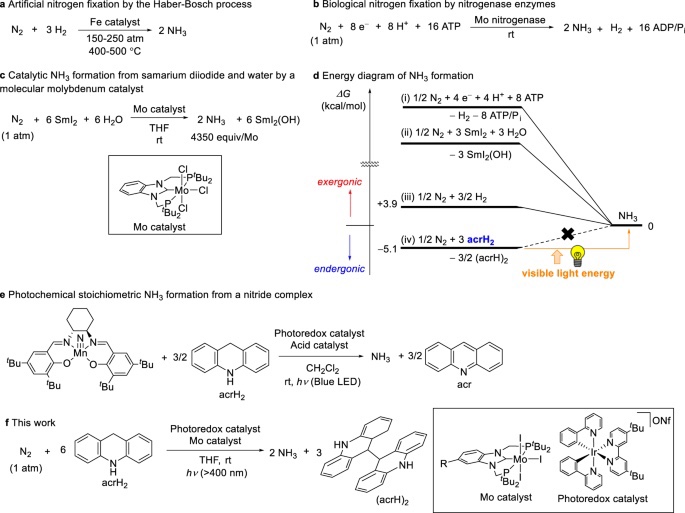

Visible Light Energy: Convert Nitrogen Gas to Ammonia!
-Synthesis under mild reaction conditions at normal temperature and pressure-
University of Tokyo Graduate School
Kyushu University
Daedong University
– Synthesis of ammonia from nitrogen gas –
He discovered that ammonia synthesis proceeds under mild reaction conditions of normal temperature and normal pressure.
Ammonia is synthesized from nitrogen gas using visible light as an energy source.
Combining an iridium photooxidation-reduction catalyst and a molybdenum catalyst,
Nitrogen gas and a hydrogen donor are reacted with visible light.
Research results:
Haber-Bosch method:
In the current ammonia synthesis method, nitrogen gas and hydrogen gas are
Ammonia is synthesized by reaction using an iron-based catalyst (Fig. 1a).
The research group is:
Utilize molybdenum complexes with PCP (phosphorus-carbon-phosphorus) type pincer ligands.
Molybdenum complexes are
Converting nitrogen to ammonia under mild reaction conditions at normal temperature and pressure,
We found that it works as an extremely active catalyst (Fig. 1b).
New experiment this time:
This time, the research group used the same catalyst as that used for the above-mentioned ammonia synthesis.
Furthermore, it was combined with an iridium photooxidation-reduction catalyst (photocatalyst) that can utilize visible light for chemical conversion.
Ammonia synthesis reaction:
We succeeded in proceeding with the energy of visible light under extremely mild reaction conditions of normal temperature and pressure (Fig. 1c).
Kyushu University
https://www.kyushu-u.ac.jp/ja/researches/view/848/
Catalytic nitrogen fixation using visible light energy
http://www.t.u-tokyo.ac.jp/en/press/pr2022-12-02-001?hs_amp=true
Énergie lumineuse visible : convertissez l’azote gazeux en ammoniac !
-Synthèse dans des conditions de réaction douces à température et pression normales-
École supérieure de l’Université de Tokyo
Université de Kyūshū
Université de Daedong
– Synthèse d’ammoniac à partir d’azote gazeux –
Il a découvert que la synthèse d’ammoniac se déroule dans des conditions de réaction douces de température normale et de pression normale.
L’ammoniac est synthétisé à partir d’azote gazeux en utilisant la lumière visible comme source d’énergie.
Associant un catalyseur de photooxydation-réduction à l’iridium et un catalyseur au molybdène,
L’azote gazeux et un donneur d’hydrogène sont mis à réagir avec la lumière visible.
Résultats de recherche:
Méthode Haber-Bosch :
Dans la méthode actuelle de synthèse de l’ammoniac, l’azote gazeux et l’hydrogène gazeux sont
L’ammoniac est synthétisé par réaction à l’aide d’un catalyseur à base de fer (Fig. 1a).
Le groupe de recherche est :
Utiliser des complexes de molybdène avec des ligands pinces de type PCP (phosphore-carbone-phosphore).
Les complexes de molybdène sont
Conversion de l’azote en ammoniac dans des conditions de réaction douces à température et pression normales,
Nous avons constaté qu’il fonctionne comme un catalyseur extrêmement actif (Fig. 1b).
Nouvelle expérience cette fois :
Cette fois, le groupe de recherche a utilisé le même catalyseur que celui utilisé pour la synthèse d’ammoniac mentionnée ci-dessus.
De plus, il a été combiné avec un catalyseur de photo-oxydation-réduction de l’iridium (photocatalyseur) qui peut utiliser la lumière visible pour la conversion chimique.
Réaction de synthèse d’ammoniac :
Nous avons réussi à procéder avec l’énergie de la lumière visible dans des conditions de réaction extrêmement douces de température et de pression normales (Fig. 1c).
Université de Kyūshū
Sichtbare Lichtenergie: Stickstoffgas in Ammoniak umwandeln!
-Synthese unter milden Reaktionsbedingungen bei normaler Temperatur und normalem Druck-
Graduiertenschule der Universität Tokio
Kyushu-Universität
Daedong-Universität
– Synthese von Ammoniak aus Stickstoffgas –
Er entdeckte, dass die Ammoniaksynthese unter milden Reaktionsbedingungen bei normaler Temperatur und normalem Druck abläuft.
Ammoniak wird aus Stickstoffgas unter Verwendung von sichtbarem Licht als Energiequelle synthetisiert.
Kombinieren eines Iridium-Photooxidations-Reduktions-Katalysators und eines Molybdän-Katalysators,
Stickstoffgas und ein Wasserstoffdonor werden mit sichtbarem Licht umgesetzt.
Forschungsergebnisse:
Haber-Bosch-Methode:
Bei dem aktuellen Ammoniak-Syntheseverfahren sind Stickstoffgas und Wasserstoffgas
Ammoniak wird durch Reaktion mit einem Katalysator auf Eisenbasis synthetisiert (Abb. 1a).
Die Forschungsgruppe ist:
Verwenden Sie Molybdänkomplexe mit Zangenliganden vom Typ PCP (Phosphor-Kohlenstoff-Phosphor).
Molybdänkomplexe sind
Umwandlung von Stickstoff in Ammoniak unter milden Reaktionsbedingungen bei normaler Temperatur und normalem Druck,
Wir fanden heraus, dass es als äußerst aktiver Katalysator wirkt (Abb. 1b).
Diesmal neues Experiment:
Diesmal verwendete die Forschungsgruppe den gleichen Katalysator wie für die oben erwähnte Ammoniaksynthese.
Darüber hinaus wurde es mit einem Iridium-Photooxidations-Reduktions-Katalysator (Photokatalysator) kombiniert, der sichtbares Licht für die chemische Umwandlung nutzen kann.
Ammoniak-Synthesereaktion:
Es ist uns gelungen, mit der Energie des sichtbaren Lichts unter extrem milden Reaktionsbedingungen bei normaler Temperatur und normalem Druck vorzugehen (Abb. 1c).
Kyushu-Universität
Catalytic nitrogen fixation using visible light energy
Nature Communications
Abstract
The synthesis of ammonia from atmospheric dinitrogen,
nitrogen fixation, is one of the essential reactions for human beings.
Because the current industrial nitrogen fixation depends on dihydrogen produced from fossil fuels as raw material,
the development of a nitrogen fixation reaction that relies on the energy provided by renewable energy, such as visible light,
is an important research goal from the viewpoint of sustainable chemistry.
Herein,
we establish an iridium- and molybdenum-catalysed process for synthesizing ammonia from dinitrogen under ambient reaction conditions and visible light irradiation.
In this reaction system,
iridium complexes and molybdenum triiodide
complexes bearing N-heterocyclic carbene-based pincer ligands act as cooperative catalysts to activate 9,10-dihydroacridine and dinitrogen, respectively.
The reaction of dinitrogen with 9,10-dihydroacridine is not thermodynamically favoured, and it only takes place under visible light irradiation.
Therefore,
the described reaction system is one that affords visible light energy–driven ammonia formation from dinitrogen catalytically.